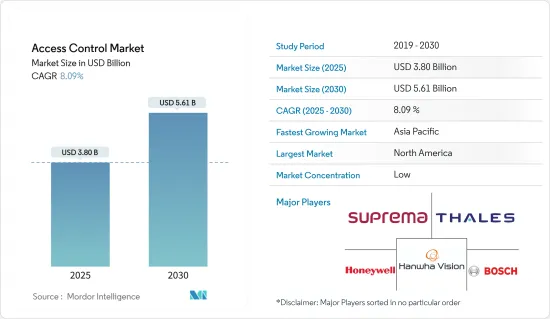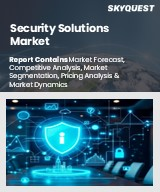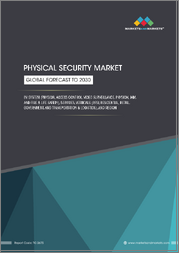
|
시장보고서
상품코드
1687112
액세스 컨트롤 시장 : 시장 점유율 분석, 산업 동향 및 통계, 성장 예측(2025-2030년)Access Control - Market Share Analysis, Industry Trends & Statistics, Growth Forecasts (2025 - 2030) |
||||||
액세스 컨트롤 시장 규모는 2025년에 38억 달러로 추정되고, 예측 기간 2025년부터 2030년까지 CAGR 8.09%로 성장할 전망이며, 2030년에는 56억 1,000만 달러에 달할 것으로 예측됩니다.

주요 하이라이트
- 바이오메트릭 장비의 가용성이 높아지고 있다는 것이 이 성장을 뒷받침하고 있습니다. 특히 지문 인증은 비용 효율적이고 널리 사용됩니다. 이 시장은 또한 장비의 상호 연결성이 증가하고 보안 위험이 증가함에 따라 혜택을 받고 있습니다.
- 사물 인터넷(IoT)은 보안 시스템의 효율성과 자동화를 강화하고, 안전한 데이터 교환을 가능하게 하며, 스마트 객체를 인터넷에 연결하는 데 중요한 역할을 합니다. 클라우드 기반 통신은 중요한 영역의 원격 모니터링을 가능하게 하며, 암호 인증을 사용하여 IoT 기반 보안 시스템의 안전을 보장합니다. 이를 통해 스마트 알람 시스템과 차고 도어 오프너 등 다양한 분야에서 IoT 기반 솔루션을 채택하여 많은 기업에서 기존 프로세스를 대체합니다.
- 사이버와 물리적 통합은 액세스 컨트롤 기술에 큰 이점을 제공합니다. 물리적 액세스 컨트롤와 사이버 액세스 컨트롤가 원활하게 작동하고 사용자에게 통합된 자격 증명을 제공함으로써 자격 증명 손실의 위험을 줄이고 복잡한 암호의 필요성을 제거합니다. 그 결과 보안 업계의 급속한 변화, 무선 액세스 포인트 및 클라우드 컴퓨팅의 도입, 스마트 인프라 프로젝트의 인기가 높아짐에 따라 입퇴실 관리 시스템 수요가 증가할 것으로 예상됩니다.
- 최신 입퇴실 관리 시스템은 생체 인증, RF, 블루투스, NFC, 근거리 무선 통신 등의 기술을 사용합니다. 그러나 테스트와 교육의 필요성, 도입 비용 등이 최종 사용자가 이러한 시스템을 채택하는 것을 망설이게 하는 요인이 되고 있습니다. 새롭게 탄생한 무선 락이나 클라우드와 조합했을 경우의 장점의 확대에 관한 낮은 사회적 인지도 및 운영상의 우려가 이 시장의 확대를 막는 요인이 되고 있습니다.
- 팬데믹의 세계적 유행도 입퇴실 관리 시스템에 영향을 미치고 있으며, 안전 절차를 실시하기 위해 거주자 데이터를 감시하는 용도가 확대되고 있습니다. 이러한 이유로 보안, 장비 및 IT 팀이 관리하는 요구 사항은 원격 근무가 확산됨에 따라 복잡해지고 과제도 증가하고 있습니다. 결과적으로 IT 업계는 보안 접근 방식과 능력을 빠르게 확장하고 귀중품 및 기밀 데이터를 보호하기 위한 고급 인증 및 기술에 대한 수요가 증가하고 있습니다. 이 때문에 앞으로 고급 인증 기술의 보급이 가속될 것으로 예상됩니다.
액세스 컨트롤 시장 동향
상업 부문이 주요 시장 점유율을 차지
- 액세스 컨트롤 시스템은 상업용 건물, 사무실 및 기업에 대한 액세스를 관리하는 수단으로 선호됩니다. 이러한 시스템은 세입자 및 직원에게 보안을 강화하고 편의성을 향상시킵니다. 또한, 입퇴실 관리 시스템은 방문자가 세입자에게 부동산 출입을 요청하는 방법을 제공할 수 있습니다.
- 직원 도난은 입퇴실 관리 시스템 수요를 창출하는 중요한 문제입니다. CompareCamp 기사에 따르면 사기와 직원 도용으로 인한 세계 손실은 연간 2조 9,000억 달러로 추정되며, 미국 기업 파산의 33%는 직원 도난과 관련이 있습니다. 입퇴실 관리 시스템을 도입함으로써 카드 키로 개인 입실을 허용하거나 거부함으로써 직원의 도난을 효과적으로 줄일 수 있습니다.
- 입퇴실 관리 시스템은 기밀 정보가 저장되는 IT실에 대한 물리적 액세스를 제한하기 위해 구축될 수 있습니다. 다양한 입퇴실 관리 시스템에는 스마트 카드 식별, 생체 인식 식별, 모바일 액세스 식별, 근접 식별 등 다양한 식별 프로토콜이 포함되어 있습니다.
- 무선 기술의 발전으로 잠금 및 컨트롤러와 같은 무선 하드웨어 구성 요소가 강화되어 물리적 케이블 및 도관의 필요성이 줄어 듭니다. 클라우드 기술 서비스는 서버 및 소프트웨어의 필요성을 줄여 안전한 원격 액세스를 용이하게 합니다.
- 액세스 컨트롤 시스템 시장은 안전 의식이 높아지고, 고급 액세스 컨트롤 시스템에 대한 수요가 증가하며, 상업 조직에서 액세스 컨트롤 장치를 채택함으로써 성장이 예상됩니다.
아시아태평양이 현저한 성장을 이룰 전망
- 아시아태평양에서는 주로 건설 부문 확대, 많은 제조업, 범죄율 증가로 중국이 계속 시장을 독점하고 있습니다. 이 나라에서는 모바일 기반 액세스 컨트롤 솔루션의 채택도 증가하는 경향이 있습니다. 중국의 스마트 도어록 분야는 생체인증과 무선통신 기술의 진보로 최근 몇 년동안 비약적으로 성장하고 있습니다.
- 일본에서는 입퇴실 관리 솔루션의 보안 측면이 정부와 기업으로부터 큰 관심을 모아 새로운 법률, 전략, 시설의 설립으로 이어지고 있습니다. 일본 기업은 터치리스 체험을 가능하게 하는 새로운 바이오메트릭스 인증 디바이스의 연구 개발에 적극적으로 임하고 있습니다.
- 인도에서는 데이터센터, 사무실 시설, 호텔, 소매점, 정부 기관 등 다양한 분야에서 액세스 컨트롤 솔루션의 도입이 급증하고 있는데, 이는 주로 보안 우려가 급속히 높아지고 범죄율이 상승하고 있기 때문입니다.
- 한국에서는 한국 디지털 개발 이니셔티브 및 2021년부터 2025년까지 디지털 정부 전략 등의 대처에 의해 국내의 디지털 변혁의 추진에 큰 힘을 쏟고 있습니다. 이 나라에서는 비접촉 기술을 육성하려는 정부의 강한 의지에 힘입어 얼굴 인증과 지문 잠금 등 비접촉 기술과 솔루션이 급속히 상승하고 있습니다.
- 호주 및 싱가포르와 같은 아시아태평양의 다른 국가에서도 IoT 기술의 상승과 COVID-19에 대한 보호의 필요성으로 인해 입퇴실 관리 솔루션의 채택이 증가하고 있습니다. 이러한 솔루션은 시설 관리의 디지털 혁명이 계속 추진되는 동안 안전하고 안전한 사회 인프라를 지원하는 수단으로 간주됩니다.
입퇴실 관리 업계 개요
입퇴실 관리 시장은 경쟁이 치열하고 세계 기업 및 지역 기업 모두 치열한 경쟁에서 더 큰 점유율을 얻기 위해 노력하고 있습니다. 진입 장벽이 높음에도 불구하고, 몇몇 신규 진출 기업들이 시장에서 성공을 거두고 있습니다. 기타 주요 기업으로는 Suprema Inc., Hanwha Vision(구 Hanwha Techwin), Thales Group(Gemalto NV), Bosch Security System Inc., Honeywell International Inc. 등이 있습니다.
2023년 3월-한화 텍윈은 한화 비전으로 사명을 바꾸고 세계비전 솔루션 제공업체로 가는 길을 걷기 시작했습니다. 이 회사는 핵심 강점과 비전 기술을 활용하여 고객이 직면한 과제를 해결하고 새로운 가치를 창출하는 혁신적인 솔루션을 제공하는 것을 목표로 하고 있습니다.
2022년 10월-ASSA ABLOY AB는 프랑스에 본사를 둔 액세스 컨트롤 솔루션 제공업체인 ALCEA의 인수를 완료했습니다. ALCEA는 ASSA ABLOY의 핵심 인프라 사업 포트폴리오에 통합되어 중요 인프라 보호 환경의 존재를 강화하고 액세스 중심의 제품 포트폴리오를 확장할 수 있습니다. 이 인수는 액세스 컨트롤 시장에서의 지위를 강화하는 ASSA ABLOY의 전략적 비전을 따릅니다.
기타 혜택
- 엑셀 형식 시장 예측(ME) 시트
- 3개월간의 애널리스트 서포트
목차
제1장 서론
- 조사 전제조건 및 시장 정의
- 조사 범위
제2장 조사 방법
제3장 주요 요약
제4장 시장 인사이트
- 시장 개요
- 업계의 매력도-Porter's Five Forces 분석
- 공급기업의 협상력
- 구매자의 협상력
- 신규 참가업체의 위협
- 경쟁 기업간 경쟁 관계
- 대체품의 위협
- 업계 밸류체인 분석
- COVID-19의 업계에 대한 영향 평가
제5장 시장 역학
- 시장 성장 촉진요인
- 범죄율과 위협 증가에 의한 입퇴실 관리 시스템 채용 확대
- 기술의 진보
- 시장의 과제
- 운영 및 ROI에 대한 우려
제6장 기술 스냅샷
- 입퇴실 관리 솔루션의 진화
- RFID 및 NFC 기술의 비교 분석
- 주요 기술 동향
제7장 시장 세분화
- 유형별
- 카드 리더 및 액세스 컨트롤 기기
- 카드식
- 근접형
- 스마트 카드(접촉 및 비접촉)
- 바이오메트릭 리더
- 전자 락
- 소프트웨어
- 기타 유형
- 카드 리더 및 액세스 컨트롤 기기
- 최종 사용자 업계별
- 상업
- 주택
- 정부기관
- 산업
- 수송 및 물류
- 헬스케어
- 군 및 방위
- 기타 최종 사용자 업계
- 지역별
- 북미
- 미국
- 캐나다
- 유럽
- 영국
- 독일
- 프랑스
- 기타 유럽
- 아시아태평양
- 중국
- 일본
- 인도
- 한국
- 기타 아시아태평양
- 세계 기타 지역
- 북미
제8장 경쟁 구도
- 기업 프로파일
- Suprema Inc.
- Hanwha Techwin Co. Ltd
- Thales Group(Gemalto NV)
- Bosch Security System Inc.
- Honeywell International Inc
- Tyco International Plc(Johnson Controls)
- Allegion PLC
- ASSA ABLOY AB Group
- Schneider Electric SE
- Panasonic Corporation
- Brivo Systems, LLC
- Identiv, Inc.
- Nedap NV
- Dormakaba Holding AG
- NEC Corporation
- Idemia Group
- Axis Communications AB
제9장 투자 분석
제10장 시장의 미래
AJY 25.04.04The Access Control Market size is estimated at USD 3.80 billion in 2025, and is expected to reach USD 5.61 billion by 2030, at a CAGR of 8.09% during the forecast period (2025-2030).

Key Highlights
- The increasing availability of biometric equipment drives this growth, particularly fingerprint recognition, which is cost-effective and widely used. The market is also benefiting from the growing interconnectedness of devices and rising security risks.
- The Internet of Things (IoT) has played a crucial role in enhancing the efficiency and automation of security systems, enabling secure data exchange, and connecting smart objects to the Internet. Cloud-based communication has made remote monitoring of critical areas possible, and password authentication is being used to secure IoT-based security systems. This has led to the adoption of IoT-based solutions in various areas, such as smart alarm systems and garage door openers, replacing traditional processes in many businesses.
- Cyber and physical integration has brought significant benefits to access control technology. Physical and cyber access controls now function seamlessly, providing users with converged credentials, reducing the risk of lost credentials, and eliminating the need for complex passwords. As a result, the demand for access control systems is expected to increase due to the rapid transformation of the security industry, the introduction of wireless access points and cloud computing, and the growing popularity of smart infrastructure projects.
- Modern access control systems use technologies such as biometrics, RF, Bluetooth, NFC, and near-field communication. However, the need for testing, training, and implementation costs can deter end-users from adopting these systems. The lack of public awareness and operational concerns regarding newly created wireless locks and their expanded benefits when combined with the cloud poses a barrier to the expansion of this market.
- The global pandemic has also impacted access control systems, with growing use for monitoring occupancy data to enforce safety procedures. This has led to more complex and challenging requirements for security, facilities, and IT teams to manage as remote working has become more prevalent. As a result, the IT industry is expanding its security approaches and capabilities rapidly, with a growing demand for sophisticated authentication and technology to protect valuables and sensitive data. This is expected to accelerate the widespread adoption of advanced authentication techniques in the future.
Access Control Market Trends
Commercial Segment to Hold Major Market Share
- Access control systems have become the preferred way to manage access to commercial buildings, offices, and businesses. These systems offer enhanced property security and convenience for tenants and staff, who can easily enter with a credential while denying access to unauthorized individuals. Access control systems can also provide a way for visitors to request property access from tenants.
- Employee theft is a significant issue that creates a demand for access control systems. According to an article by CompareCamp, global loss from fraud and employee theft is estimated to be USD 2.9 trillion annually, and 33% of corporate bankruptcies in the United States are linked to employee theft. Deploying access control systems can effectively reduce employee theft by permitting or denying entry to individuals with a key card.
- Access control systems can be built to restrict physical access to IT rooms where sensitive information is stored. Different access control systems come with various identification protocols, such as smart card identification, biometric identification, mobile access identification, and proximity identification.
- Advancements in wireless technology have enhanced wireless hardware components such as locks and controllers, reducing the need for physical cables and conduits. Cloud technology services are also reducing the requirement for servers and software, facilitating secure remote access.
- The market for access control systems is expected to grow due to increasing safety consciousness, the growing demand for high-level access control systems, and the adoption of access control devices in commercial organizations.
Asia Pacific to Witness Significant Growth
- In the Asia-Pacific region, China continues to dominate the market, mainly due to its expanding construction sector, a large number of manufacturing industries, and a growing crime rate. The adoption of mobile-based access control solutions is also on the rise in the country. China's smart door lock segment has grown exponentially in recent years, driven by advancements in biometric recognition and wireless communication technologies.
- In Japan, the security aspect of access control solutions has gained significant interest from the government and enterprises, leading to the establishment of new legislation, strategies, and facilities. Japanese companies are actively researching and developing newer biometric and authentication devices that enable a touchless experience.
- India is witnessing a surge in the deployment of access control solutions in various sectors, including data centers, office premises, hotels, retail stores, and government institutions, primarily due to the rapidly growing security concerns and increasing crime rates.
- South Korea is making significant efforts to advance digital transformation in the country, with initiatives such as the Korea Digital Development initiative and digital government strategy for 2021-2025. Contactless technology and solutions, such as facial recognition and fingerprint locks, are emerging rapidly in the country, driven by the government's strong will to foster contactless technologies.
- Other countries in the Asia-Pacific region, such as Australia and Singapore, are also witnessing a rise in the adoption of access control solutions, driven by the rising IoT technologies and the necessity for protections against COVID-19. These solutions are seen as a means to support safe and secure social infrastructure as the digital revolution of facility management continues to propel forward.
Access Control Industry Overview
The access control market is highly competitive and comprised of both global and regional players striving for a larger share in a fiercely contested space. Despite the high barriers to entry, several new entrants have successfully made a mark in the market. Some of the notable players in the industry include Suprema Inc., Hanwha Vision (formerly known as Hanwha Techwin Co. Ltd), Thales Group (Gemalto NV), Bosch Security System Inc., Honeywell International Inc., and others.
In March 2023, Hanwha Techwin was rebranded as Hanwha Vision, signaling the start of the company's journey to become a global vision solution provider. The company aims to leverage its core strengths and vision technology to offer innovative solutions that solve the challenges faced by its customers and create new value.
In October 2022, ASSA ABLOY AB completed the acquisition of ALCEA, a French-based access control solutions provider. ALCEA will be integrated into ASSA ABLOY's Critical Infrastructure business portfolio, enabling the company to enhance its presence in critical infrastructure protection environments and expand its product access-centered product portfolio. This acquisition is in line with the company's strategic vision to strengthen its position in the access control market.
Additional Benefits:
- The market estimate (ME) sheet in Excel format
- 3 months of analyst support
TABLE OF CONTENTS
1 INTRODUCTION
- 1.1 Study Assumptions and Market Definition
- 1.2 Scope of the Study
2 RESEARCH METHODOLOGY
3 EXECUTIVE SUMMARY
4 MARKET INSIGHTS
- 4.1 Market Overview
- 4.2 Industry Attractiveness - Porter's Five Forces Analysis
- 4.2.1 Bargaining Power of Suppliers
- 4.2.2 Bargaining Power of Buyers
- 4.2.3 Threat of New Entrants
- 4.2.4 Intensity of Competitive Rivalry
- 4.2.5 Threat of Substitutes
- 4.3 Industry Value Chain Analysis
- 4.4 Assessment of the Impact of COVID-19 on the Industry
5 MARKET DYNAMICS
- 5.1 Market Drivers
- 5.1.1 Growing Adoption of Access Control Systems owing to Rising Crime Rates and Threats
- 5.1.2 Technological Advancements
- 5.2 Market Challenges
- 5.2.1 Operational and ROI Concerns
6 TECHNOLOGY SNAPSHOT
- 6.1 Evolution of Access Control Solutions
- 6.2 Comparative Analysis of RFID and NFC Technology
- 6.3 Key Technological Trends
7 MARKET SEGMENTATION
- 7.1 By Type
- 7.1.1 Card Reader and Access Control Devices
- 7.1.1.1 Card-based
- 7.1.1.2 Proximity
- 7.1.1.3 Smart Card (Contact and Contactless)
- 7.1.2 Biometric Readers
- 7.1.3 Electronic Locks
- 7.1.4 Software
- 7.1.5 Other Types
- 7.1.1 Card Reader and Access Control Devices
- 7.2 By End User Vertical
- 7.2.1 Commercial
- 7.2.2 Residential
- 7.2.3 Government
- 7.2.4 Industrial
- 7.2.5 Transport and Logistics
- 7.2.6 Healthcare
- 7.2.7 Military and Defense
- 7.2.8 Other End User Verticals
- 7.3 By Geography
- 7.3.1 North America
- 7.3.1.1 United States
- 7.3.1.2 Canada
- 7.3.2 Europe
- 7.3.2.1 United Kingdom
- 7.3.2.2 Germany
- 7.3.2.3 France
- 7.3.2.4 Rest of the Europe
- 7.3.3 Asia Pacific
- 7.3.3.1 China
- 7.3.3.2 Japan
- 7.3.3.3 India
- 7.3.3.4 South Korea
- 7.3.3.5 Rest of the Asia Pacific
- 7.3.4 Rest of the World
- 7.3.1 North America
8 COMPETITIVE LANDSCAPE
- 8.1 Company Profiles
- 8.1.1 Suprema Inc.
- 8.1.2 Hanwha Techwin Co. Ltd
- 8.1.3 Thales Group (Gemalto NV)
- 8.1.4 Bosch Security System Inc.
- 8.1.5 Honeywell International Inc
- 8.1.6 Tyco International Plc (Johnson Controls)
- 8.1.7 Allegion PLC
- 8.1.8 ASSA ABLOY AB Group
- 8.1.9 Schneider Electric SE
- 8.1.10 Panasonic Corporation
- 8.1.11 Brivo Systems, LLC
- 8.1.12 Identiv, Inc.
- 8.1.13 Nedap NV
- 8.1.14 Dormakaba Holding AG
- 8.1.15 NEC Corporation
- 8.1.16 Idemia Group
- 8.1.17 Axis Communications AB

















